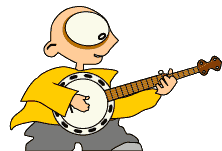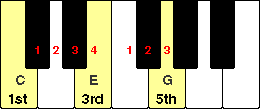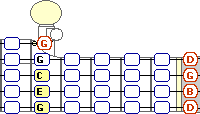

 |
 |
See also, Part 2 - sevenths and minors
You may have seen chord books that list out the hundreds of chord combinations. I think for most of us these books are daunting and rather useless. The idea of this page is to explain the logic behind chords so you don't have to rely on remembering the fingering patterns alone. Having said that, understanding how chords work will certainly be of benefit to you, but it doesn't excuse you from the many hours of practice required so you can play them smoothly and instinctively.
If you are a beginner or intermediate banjo player, you don't need to be too concerned about diminished or augmented chords, so relax! For most bluegrass music you can get by just fine using only majors, minors and sevenths. In Chord Theory Part 1 I discuss the basic concepts behind forming major chords. In Chord Theory Part 2 I explain how to further these concepts to form seventh and minor chords.
Let's start by explaining the musical terms that surround chords. For music with traditional harmony, a chord is the simultaneous playing of 3 or more notes. Chords with 3 notes (the most common) are called triads, and chords with 4 notes (such as sixths and sevenths) are called tetrads. Each triad has a root and this is where the name of the chord comes from (for example, the root of a C chord is C). In Western music, the sequence of tones in an octave form the major scale. The scale begins and ends with the same note, which is called the tonic. Next we'll take a look at the chromatic scale, as it contains all the 12 tones of our notation system from which all chords and scales are derived.
It's easier to picture the chromatic scale on a keyboard before transferring this knowledge to a banjo neck. The diagram below shows an entire octave with all the 12 chromatic tones listed. A very important concept to remember is that these 12 steps are actually half-steps. A whole-step is 2 half-steps. To move from 1 fret to the next on a banjo is to move 1 half-step.
The black keys have 2 names because they can either be sharp (a half-step higher in pitch) or flat (a half-step lower in pitch). This does not mean we count them twice.

Each note in a triad is given an interval name. The first note, (the root), is called the 1st; the middle note is the 3rd and the third note is called the 5th. You need to remember that in a major chord the 3rd is 2 whole steps (or 4 half-steps) up from the 1st and the 5th is 1.5 whole-steps (3 half-steps) up from the 3rd. I'll illustrate this in 3 ways:
The first example shows the C chord (highlighted in yellow) on the keyboard. Count up 4 half-steps (2 whole-steps) from the root to get the 3rd, which is E. From E, count up 3 half-steps (1.5 whole-steps) to get the 5th, which is G.

This example shows the C chord in notation. The lowest note (1st) is the root and a C. The middle note (3rd) is an E and the top note (5th) is an G. It's a little harder to count the half-steps in notation unless you can rattle off the chromatic scale without having to think about it.

And finally, here is a C chord on the banjo. I'm using the barre chord fretted at the 5th fret in this example. On a stringed instrument such as a banjo, it's common to add a forth note to make the chord sound fuller. The diagram below shows the 1st, 3rd and 5th highlighted in yellow with another 5th added (G on the 4th string). Although I'm playing 4 notes, this chord is still a triad because 2 of the notes are G. If I was to add another note such as a 7th, the triad would become a tetrad.

Remember that the Western form of music has been around a lot longer then banjos and a banjo is simply an instrument capable of playing all the notes in the chromatic scale. Although the sound of the 5 string banjo is mostly suited to bluegrass music, technically it can be used to play any style of music. And just like other instruments, to play chords it's simply a matter of finding the most convenient way to strike 3 notes or more at once. To see all the possible locations (inversions) of each of the major chords, see the page on major chord inversions.
In Chord Theory Part 2 I'll explain how to form seventh and minor chords. To compliment what you learn about basic chord theory, I'd advise learning the chromatic scale so it eventually becomes as natural as counting from 1 to 12.
Go on to Part 2 - sevenths and minors